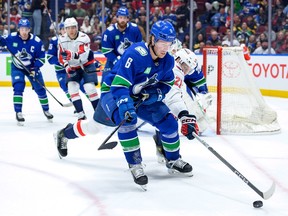An NHL game is filled with small moments and skills. Here’s what the Vancouver Canucks say you should look for.

Article content
So you’re hosting a playoff party? You want to sound smart?
Advertisement 2
Article content
The are all the obvious things for fans to know: Who’s the top scorer, who’s the No. 1 goalie, what Rick Tocchet said before the game about his matchup preferences.
Article content
Those are all easy.
We’re here to give you a few key points we have gathered from players in recent weeks, to help you impress your friends with things they didn’t know before.
Over the past few months, we’ve been surveying Canucks players for what they think are the most underrated skills in hockey. What is a skill that keeps a guy in the NHL? What’s something that you realized you had to master that would help you stay in the NHL?
Here’s the most intriguing responses.
Body positioning
“Body position,” Conor Garland said, quickly, almost cutting off the question. Outsiders have made note of his talents at using his small stature to get underneath larger opponents, but the speedy winger pointed to another diminutive teammate as a better example: Nils Hoglander.
Article content
Advertisement 3
Article content
“Look at Hoggy,” he went on. “He had to learn to battle. Look at the goals he scores. He gets those because of body position.”
Hoglander also said body positioning, but for different reasons.
“Protecting the puck,” he said. That was a big thing he realized he had to understand once he arrived in the NHL: How good players are at protecting the puck, at keeping you from taking the puck away from them.
Sam Lafferty highlighted something that is also about body positioning: wall play.
“Guys are on you so quick. It’s smarts. It’s positioning. Think of the D-man coming back for the puck, he has to be ready for a forechecker right away,” he said.
How to use your stick
When we spoke with Brock Boeser, the Canucks had just faced the Vegas Golden Knights a few days before.
Advertisement 4
Article content
“Reach,” he said. “Like (Alex) Pietrangelo. Oh man. You think you have space and he takes it away.”
Boeser’s new teammate Carson Soucy is very adept as well at using his stick to disrupt the efforts of puck carriers.
“Yeah, he’s great at it,” Boeser concurred.
Teddy Blueger pointed out how well the Carolina Hurricanes’ Jaccob Slavin uses a combination of body positioning and stick work to make zone entries very difficult.
“You think you can beat him, but you can’t. He uses his body to control the space so well, and his stick makes it really hard to have any control,” he said.
Pius Suter is known as a smart player. He’s not big, but he also makes great use of his stick.
“You need a good stick on puck, like defensively. If you know where to put it, you can disrupt. You can pick off passes,” he explained.
Advertisement 5
Article content
Where to stand and where to look
Goalies have a unique view of the game, so Casey DeSmith’s answer was no surprise.
“You’ve got to have awareness, how to read the play.”
If you can’t master those, he said, you are going to get beaten all the time, no matter how good your positioning may be.
“You’ve got to have hockey IQ, of knowing what to do,” Nikita Zadorov reinforced. “You can have skills, but if you don’t know how to use it you’re nothing.”
Who wins more puck battles
Ian Cole knows the playoffs. He’s made the playoffs with eight different teams. He’s appeared in the playoffs with a different squad in each of the past five seasons.
There’s a reason his talents are coveted.
“Winning 50/50 battles. Will is the key to winning,” he said. “If you are winning 65 per cent, how much more value is that, how much more are you turning the tide over time?
Advertisement 6
Article content
The speed players make decisions at
We see how fast things happen, now try to imagine being in the thick of it.
That’s what struck Vasily Podkolzin when he first arrived in the NHL, and what struck him again when he returned to the NHL last month.
“Puck management is so hard,” he said. “These guys, they care about the puck, because it’s so hard to get back.”
His Russian teammate Ilya Mikheyev had an established KHL career before he moved to the NHL. The lack of space on the ice, as well as the speed of decision-making, were the things he realized were key to success.
“It’s on a line from puck management,” he said. “You take care with each puck (possession).”
Mark Friedman doesn’t play a lot, but he knows one thing is essential when he’s in the lineup: push the play.
Advertisement 7
Article content
“You have to be always moving. Look at (Colorado’ Nathan) MacKinnon,” he said. “Guys don’t stand around in this league.”
Goalie interference is the most consistently called thing in hockey
And here’s one from your author: It’s always amazing to see people get up in arms about goals being called back for goalie interference, but in reality it’s as consistent as it gets, especially in the NHL where most other calls get made with an unpredictable capriciousness.
It’s a pretty simple question that the league asks when looking at video in these instances: was the goalie impeded in any way from playing his position in the crease.
If the answer is yes, it’s not going to be a goal.
Article content
reference: theprovince.com
